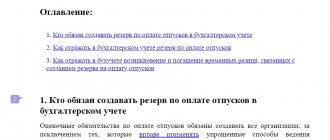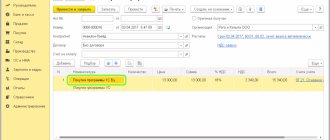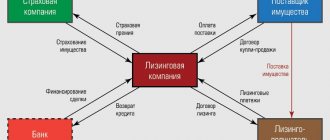Returnable and non-returnable packaging
The container in which the materials (goods) were received may be returnable or non-returnable (Article 517 of the Civil Code of the Russian Federation, paragraph 179 of the Methodological Instructions, approved by Order of the Ministry of Finance of Russia dated December 28, 2001 No. 119n).
Returnable packaging includes reusable packaging. The organization must return it, even if this is not provided for in the supply contract. There is no need to return such containers if the contract states that they cannot be returned. The organization must return disposable containers if this is provided for in the contract. In other cases, such packaging is considered non-returnable. This is stated in Article 517 of the Civil Code of the Russian Federation and paragraphs 162, 163, 179 of the Methodological Instructions, approved by Order of the Ministry of Finance of Russia dated December 28, 2001 No. 119n.
To control the packaging that the buyer has, the parties can periodically draw up a reconciliation report for returnable packaging in circulation.
Accounting for non-returnable packaging
Accounting for non-returnable packaging depends on whether its cost is included in the cost of materials (goods) or whether the organization pays for the packaging separately.
If the cost of the container is not highlighted separately, it is not necessary to take it into account separately, since it forms the cost of materials (goods) that were received in this container (clause 63 of the Methodological Instructions, approved by Order of the Ministry of Finance of Russia dated December 28, 2001 No. 119n, clause 6 PBU 5/01).
However, if an organization plans to use packaging in its activities or sell it, it must be taken into account at the market price as part of the organization’s other income. Determine the market price based on the amount that can be received from the sale of this container (paragraph 2, clause 9 of PBU 5/01). Take into account the packaging at the time of receipt of materials (goods) that were received in this container (clause 178 of the Methodological Instructions, approved by Order of the Ministry of Finance of Russia dated December 28, 2001 No. 119n).
Do the following wiring:
Debit 10-4 (41-3) Credit 91-1
– packaging has been capitalized, the cost of which the organization does not pay.
This procedure is established in paragraphs 42, 44, 178 of the Methodological Instructions, approved by Order of the Ministry of Finance of Russia dated December 28, 2001 No. 119n, and the Instructions for the Chart of Accounts.
The contract may provide that the organization must pay for non-returnable packaging separately from the materials (goods) received in it. In this case, consider the container at the actual cost. Determine the actual cost of the container received based on the data from the primary documents. The name, quantity and cost of the container must be highlighted as a separate line in shipping documents (for example, in a payment request, invoice, waybill, etc.). Also, containers can be received on the basis of a separate primary document. This procedure is established in paragraphs 42, 44, 178 of the Methodological Instructions, approved by Order of the Ministry of Finance of Russia dated December 28, 2001 No. 119n. In this case, reflect the receipt of non-returnable packaging with the following entries:
Debit 10-4 (41-3) Credit 60 (76)
– packaging has been capitalized, the cost of which is paid separately by the organization;
Debit 19 Credit 60 (76)
– VAT on purchased packaging is taken into account.
If the organization does not plan to further use non-returnable packaging, the cost of which was paid separately, take it into account along with the materials (goods) purchased in it (clause 178 of the Methodological Instructions, approved by Order of the Ministry of Finance of Russia dated December 28, 2001 No. 119n). In this case, do the wiring:
Debit 10-1 (41-1) Credit 60 (76)
– materials (goods) in containers are capitalized;
Debit 19 Credit 60 (76)
– VAT on purchased materials (goods) in containers is taken into account.
This procedure is established in the Instructions for the chart of accounts (accounts 10, 41, 19).
Which accounts account for returnable packaging?
Organizations engaged in trade and public catering keep records of returnable containers on account 41.03.
All other organizations account for returnable packaging on account 10.04.
Technological (necessary for the production process) and inventory containers (used for production or household needs) are accounted for in all organizations on accounts 01.01 or 10.01, depending on the service life and cost of such containers.
In addition, based on the decision of the management of the enterprise, it is possible to establish in the accounting policy the keeping of records of returnable packaging on off-balance sheet account 002, since such packaging does not become the property of the buyer.
Accounting for returnable packaging
Returnable packaging is not included in the cost of products sold. Therefore, its cost should be highlighted in the primary documents for the supply of materials (goods) as a separate line. The price of returnable packaging, which the organization must transfer to the supplier in the event of non-return of the packaging, must be determined in the contract (purchase and sale agreement, supply agreement, etc.). This is stated in paragraph 174 of the Methodological Instructions, approved by order of the Ministry of Finance of Russia dated December 28, 2001 No. 119n.
An agreement for the supply of materials (goods) may stipulate that in order to fulfill the obligation to return the packaging, the organization must pay a deposit. In this case, take into account the received containers at the collateral value, which is established in the contract. When transferring the deposit for containers, make the following entries:
Debit 60 (76) Credit 50 (51...)
– the amount of the deposit has been transferred to secure the obligation to return the packaging;
Debit 009
– reflects the amount of the deposit for returnable packaging.
This procedure is established in paragraphs 164, 182 of the Methodological Instructions, approved by Order of the Ministry of Finance of Russia dated December 28, 2001 No. 119n, Instructions for the chart of accounts.
Account for the receipt of returnable packaging at the cost indicated in the primary documents for the supply of materials (goods) or at the collateral value. Take into account the packaging at the time of receipt of materials (goods) that were received in this container (clause 178 of the Methodological Instructions, approved by Order of the Ministry of Finance of Russia dated December 28, 2001 No. 119n).
Do the following wiring:
Debit 10-4 (41-3) Credit 60 (76)
– returnable packaging has been received, the cost of which is paid separately by the organization.
Return the packaging to the supplier using the following posting:
Debit 60 (76) Credit 10-4
– returnable containers are returned to the supplier of materials (goods).
This procedure follows from paragraphs 182 and 183 of the Methodological Instructions, approved by Order of the Ministry of Finance of Russia dated December 28, 2001 No. 119n, Instructions for the chart of accounts (accounts 10, 41).
After returning the container, the supplier must return to the organization the funds that were previously transferred to him for the container (deposit value). When you receive funds from the supplier, make the following entry:
Debit 50 (51...) Credit 60 (76)
– the deposit amount has been returned;
Credit 009
– the amount of the deposit for returnable packaging has been written off.
This procedure is established in paragraph 164 of the Methodological Instructions, approved by Order of the Ministry of Finance of Russia dated December 28, 2001 No. 119n, and in the Instructions for the chart of accounts.
If, in violation of the contract, the organization does not return the container, then it will not receive the deposit back. In this case, the deposit amount will be the payment for the purchased container.
Make the following entries in your accounting:
Debit 10-4 (41-3) Credit 60 (76)
– the receipt of returnable packaging at the deposit value was reversed;
Debit 10-4 (41-3) Credit 60 (76)
– containers are capitalized at cost (excluding VAT);
Debit 19 Credit 60 (76)
– VAT on purchased packaging is taken into account based on the supplier’s invoice;
Credit 009
– the amount of the deposit for returnable packaging has been written off.
Such rules are established in the Instructions for the chart of accounts (accounts 10, 19, 60, 76, 91, 009).
How to display packaging costs correctly?
Expenses for disposable packaging can be displayed in accounting in several ways - it all depends on the type of activity of the enterprise.
In production, packaging is part of the material and production assets. To make accounting entries, account 10 “Materials” is used, as well as subaccount 4 “Containers and container materials”.
Subsequent cost accounting is determined by at what stage of production the product is placed in disposable containers:
- Packaging directly during the production process involves writing off expenses for inventories to the debit of account 20 (the amount is included in the cost of goods).
- Packaging of products after production indicates that the amount of costs will be written off to the debit of account 44.
BASIC: non-returnable packaging
When calculating income tax, take into account the cost of non-returnable packaging in the cost of materials (goods) that were received by the organization in this container (clause 3 of Article 254 of the Tax Code of the Russian Federation).
An example of how the receipt of non-returnable packaging is reflected in accounting and tax purposes. The organization pays the cost of the packaging separately, and it does not plan to use it in the future. The organization applies a general taxation system
LLC "Proizvodstvennaya" is engaged in the production of meat and sausage products. In May, the organization purchased raw materials for production. In the same month, Master fully paid the supplier for raw materials. The raw materials arrived at the organization in plastic packaging, the cost of which is paid separately by the “Master”. Polyethylene packaging is single-use packaging, which means it is non-returnable. The contract does not contain conditions for returning the packaging.
In shipping documents, the cost of packaging is highlighted as a separate line. In accordance with these documents, the cost of raw materials is 7080 rubles. (including VAT - 1080 rubles), packaging cost - 590 rubles. (including VAT - 90 rubles).
Since the packaging is non-returnable and the organization does not plan to use it, the accountant included its cost in the cost of purchased raw materials. At the same time, the accountant made the following entries.
May:
Debit 10-1 Credit 60 – 6500 rub. (7080 rub. – 1080 rub. + 590 rub. – 90 rub.) – raw materials in containers are capitalized;
Debit 19 Credit 60 – 1170 rub. (1080 rub. + 90 rub.) – VAT on purchased materials in containers is taken into account;
Debit 60 Credit 51 – 7670 rub. (RUB 7,080 + RUB 590) – payment is transferred to the supplier.
When calculating income tax for May, Master's accountant took into account the cost of non-returnable packaging (500 rubles) and raw materials (6,000 rubles) as part of material expenses.
Situation: is it necessary to take into account the cost of non-returnable packaging received along with materials (goods) when calculating income tax? The organization does not pay separately for the cost of packaging. The organization plans to use the packaging in production or sell it.
No no need.
Containers, the cost of which is included in the total cost of materials (goods) and which the organization plans to use in the future, cannot be regarded as received free of charge (Clause 2 of Article 248 of the Tax Code of the Russian Federation). This means that the market value at which such packaging is accepted for accounting cannot be taken into account as part of non-operating income on the basis of paragraph 8 of Article 250 of the Tax Code of the Russian Federation.
Thus, the cost of packaging, recognized as income in accounting, is not taken into account as income in tax accounting. Therefore, a permanent difference is formed in accounting, which leads to the emergence of a permanent tax asset (clauses 4, 7 of PBU 18/02). In this case, do the wiring:
Debit 68 subaccount “Calculations for income tax” Credit 99
– reflects a permanent tax asset on income that does not increase taxable profit.
At the time of sale or transfer of containers for production, do not take their cost into account as expenses. This is explained by the fact that it has already been taken into account as part of material costs when purchasing materials (goods) in such containers (clause 3 of Article 254 of the Tax Code of the Russian Federation). Moreover, if an organization plans to sell containers, when calculating income tax, take into account only the income from this operation (clause 1 of Article 248 of the Tax Code of the Russian Federation).
Don't throw away empty containers...
In non-trade organizations and budgetary institutions, all kinds of non-returnable containers sometimes accumulate. With prudent housekeeping, accountants may have questions: how to capitalize this container, how to register its sale? It is for such “economic” accounting workers that our article is written.
When conducting business activities, material assets are transported to the buyer in so-called non-returnable containers. For example, these could be cardboard boxes and glass juice jars that accumulate in cafeterias and buffets. Typically, the cost of this container is included in the purchase price and is not highlighted separately in the receipt documents.
It is precisely this type of packaging that is classified as non-returnable in accounting.
Capitalization of non-returnable packaging
As mentioned, the cost of non-returnable packaging is included in the purchase price. Capitalization of material assets at the purchase price and further write-off are carried out in the usual manner. For tax accounting purposes, the cost of non-returnable containers and packaging accepted from a supplier with inventories is included in the amount of expenses for their acquisition (clause 3 of Article 254 of the Tax Code of the Russian Federation).
In order to take into account non-returnable packaging, primary documents are required. There are several options for creating primary documents for container accounting:
· posting according to the act;
· capitalization after inventory.
Capitalization according to the act.
At the end of the working day, week, month, the appointed responsible person or commission draws up an act for the receipt of packaging. The form of the act is developed independently and approved in the accounting policy. The main requirement is compliance with the provisions of paragraph 2 of Art. 9 of the Law of November 21, 1996 No. 129-FZ “On Accounting” regarding mandatory details.
Capitalization after inventory.
In a non-trading organization (hereinafter - organization) or in a budgetary institution (hereinafter - institution), a permanent inventory commission is created by order. Moreover, it is better to specifically stipulate in the order that the purpose of creating the commission is to take an inventory of non-returnable containers. The order must determine the frequency of the inventory (for example, weekly).
Based on the requirements of the Methodological Guidelines for the inventory of property and financial obligations, approved by Order of the Ministry of Finance of the Russian Federation dated June 13, 1995 No. 49, an inventory list and a matching statement are compiled. These documents are the basis for accepting containers for accounting.
In both cases, packaging must be posted at market prices. This procedure is defined for both accounting (Article 11 of Law No. 129-FZ) and tax accounting (subclause 8 of Article 250 of the Tax Code of the Russian Federation).
It is necessary to explain why two options are offered. This is due to the taxation of container sales operations. In paragraph 2 of Art. 254 of the Tax Code of the Russian Federation determines that the cost of selling inventories in the form of surpluses identified during the inventory is determined as the cost of capitalization during the inventory, multiplied by the income tax rate (24%). That is, for the first case, the Tax Code does not define a special procedure for writing off as expenses the cost of inventories recorded as income of an organization or institution. In the second case, it is necessary to comply with the requirements of the Tax Code of the Russian Federation.
EXAMPLE
The cost of packaging when capitalized in tax accounting was 10 rubles.
When sold in tax accounting, only 2.40 rubles can be written off as a decrease in income. (10 rubles x 24%).
These recommendations are based on a literal reading of the Tax Code of the Russian Federation, therefore, when choosing the first option, you must be prepared to defend your position before the tax authorities, guided by clause 7 of Art. 3 Tax Code of the Russian Federation.
Now let’s figure out which accounting accounts need to account for containers in a non-trading organization. Since the sale of non-returnable packaging is not the main activity of the organization, then, according to the terminology of the Methodological Guidelines for Accounting for Inventories, approved by Order of the Ministry of Finance of Russia dated December 28, 2001 No. 119n (hereinafter referred to as the Guidelines), such an organization is called “non-trading” (clause 217 Methodical instructions). In non-trading organizations, inventories, which represent surplus material assets, are accounted for in account 41 “Goods” (clause 222 of the Guidelines). In principle, this also corresponds to the economic nature of the packaging taken into account.
The following entries should be made in accounting:
Debit 41 Credit 91
subaccount 1 “Other income”
— posting of containers.
REFERENCE
If an organization incurs additional costs associated with the storage and sale of containers, it has the right to account for these costs in account 44 “Sales expenses” (clause 226 of the Guidelines) (for example, detergents for washing cans). At the end of the month, these expenses are debited in full to the sales account.
For a budgetary institution, the Instructions for Budget Accounting (approved by Order of the Ministry of Finance of Russia dated February 10, 2006 No. 25n) do not contain the concept of “goods”, therefore the institution should record containers in account 010506000 “Other inventories” (clause 66 of the Instructions for Budget Accounting).
To avoid misunderstandings with regulatory authorities, it is better to play it safe by sending a letter to the chief manager with a request to approve the proposed methodology and consolidate it in your accounting policies.
Let's try to figure out what type of activity the packaging in question belongs to. There are also two options here:
· budgetary activities;
· income-generating activities.
Budgetary activities.
If budget funds were paid for purchased goods in non-returnable containers, then the packaging must be posted to the budget account.
Income-generating activities.
If funds from income-generating activities were paid for purchased goods in non-returnable containers, then the packaging must be posted to the income-generating activity account.
The following entries should be made in accounting:
Debit 010506000
“Other inventories”
Credit 040101172
“Income from the sale of assets”
— posting of containers.
Sales of non-returnable packaging
Let's consider the reflection in accounting and tax accounting of the sale of non-returnable packaging.
In non-trading organizations, the sale of goods is reflected in account 90 “Sales”. This procedure is defined in paragraph 229 of the Guidelines:
Debit 62 Credit 90 s
subaccount 1 “Revenue”
— sale of containers for non-cash payments upon shipment
Debit 90
subaccount 2 “Cost of sales”
Credit 41
- write-off of the cost of packaging sold
Debit 90
subaccount 3 “Value added tax”
Credit 68
subaccount “Value added tax”
— VAT debt is reflected.
At the end of the month, the debit and credit turnovers of the sales account are compared and the financial result from the sale is reflected:
Debit 99 Credit 90
subaccount 9 “Profit/loss from sales”
- loss
Debit 90
subaccount 9 “Profit/loss from sales”
Credit 99
- profit.
In budgetary institutions, postings depend on the type of activity for which the packaging is accounted for. Let's consider selling containers in bulk by bank transfer.
The Ministry of Finance of Russia, in Letter No. 02-14-10a/1641 dated June 23, 2006, explained that starting from January 1, 2006, all letters from the Ministry of Finance and the Federal Treasury explaining certain provisions of Instruction No. 70n are applied to the extent that does not contradict Instruction No. 25n.
To account for purchased packaging at the expense of budgetary activities, the basis for accounting entries is Letter of the Federal Treasury dated December 13, 2005 No. 42-7.1-01/2.2-371.
Debit 120509560 Credit 130305730
— accrual of income for sold packaging
Debit 220510560 Credit 240101180
— accrual of the buyer’s debt for VAT, subject to transfer by the budgetary institution to the budget
Debit 140101172 Credit 110506440
— write-off of shipped (sold) packaging.
For extra-budgetary activities, the procedure for reflecting financial and economic activities is regulated by Letter of the Federal Treasury dated May 29, 2006 No. 42-7.1-15/2.2-221.
Debit 220509560 Credit 240101172
—accrual of income from the sale of containers based on an agreement or invoice
Debit 240101172 Credit 230304730
—accrual of VAT debt subject to transfer by a budgetary institution to the budget on the basis of an issued invoice
Debit 240101172 Credit 210506440
— write-off of shipped (sold) packaging.
In tax accounting, the full cost of the container is written off. However, it must be remembered that in the case of capitalization of containers based on the results of inventory in tax accounting, the written-off value is determined taking into account the income tax rate (clause 2 of Article 254 of the Tax Code of the Russian Federation).
BASIC: returnable packaging
Do not take into account the cost of returnable packaging when calculating income tax. Moreover, if the price of returnable packaging is included in the total cost of materials (goods), it must be highlighted. The container must be valued at the value that can be obtained from its possible use or sale. For example, from handing over empty boxes to waste paper, from selling empty plastic containers to the public, etc.
This procedure for accounting for containers is prescribed in paragraph 3 of Article 254 of the Tax Code of the Russian Federation.
The amount of the deposit transferred to the supplier for returnable packaging should not be taken into account as expenses when calculating income tax (Clause 32, Article 270 of the Tax Code of the Russian Federation).
An example of how the receipt of returnable packaging is reflected in accounting and taxation. To ensure the return of the packaging, the organization transferred a deposit to the supplier. The organization applies a general taxation system
In May, Alpha LLC purchased a batch of kefir. The cost of the purchased batch of kefir is 11,000 rubles. (including VAT - 1000 rubles).
Boxes of kefir are packed in 10 plastic pallets. According to the contract, the organization must return them to the supplier.
The deposit price of one pallet is 300 rubles. In May, Alpha transferred a deposit in the amount of 3,000 rubles to the supplier’s bank account. (300 rub. × 10 pcs.). In June, the organization paid for the goods and returned the container.
Alpha's accountant made the following entries in the accounting records.
May:
Debit 10-1 Credit 60 – 10,000 rub. – the actual cost of kefir is reflected;
Debit 19 Credit 60 – 1000 rub. – VAT on purchased kefir is taken into account;
Debit 10-4 Credit 76 – 3000 rub. – reflects the collateral value of returnable packaging received from the supplier;
Debit 76 Credit 51 – 3000 rub. – the amount of the deposit has been transferred to secure the obligation to return the packaging;
Debit 009 – 3000 rub. – reflects the amount of the deposit for returnable packaging.
June:
Debit 60 Credit 51 – 11,000 rub. – payment for sold kefir is transferred;
Debit 76 Credit 10-4 – 3000 rub. – the container is returned to the supplier;
Debit 51 Credit 76 – 3000 rub. – the deposit amount has been returned;
Credit 009 – 3000 rub. – the amount of the deposit for returnable packaging has been written off.
When calculating income tax, the organization did not take into account the cost of returnable packaging (3,000 rubles) and the amount of the deposit (3,000 rubles).
If, in violation of the contract, the organization does not return the container, then it will not receive the deposit back. In this case, the amount of the deposit should be considered a payment for the purchase of the container. The organization transfers ownership of it, that is, the container is sold (Article 218 of the Civil Code of the Russian Federation, paragraph 1 of Article 39 of the Tax Code of the Russian Federation). In this case, the supplier will charge VAT and issue you an invoice (subclause 1, clause 1, article 146 of the Tax Code of the Russian Federation).
For more information, see:
- How to record transactions with containers when selling purchased goods;
- How to record transactions with containers when selling your own products.
Taxation of transactions with returnable packaging
The procedure for taxation of transactions with returnable packaging in the Tax Code of the Russian Federation is described in paragraph 7 of Art. 154. In particular, when transferring goods in returnable containers, for which the contract provides for the payment of a deposit, the deposit value of the container is not subject to inclusion in the tax base when calculating VAT. This rule applies only if the container is returned to the supplier. If returnable packaging is not returned, the operation of transferring the container to the buyer is considered a sale of packaging subject to VAT.
IMPORTANT! The supplier, acting as a pledge holder, reflects the cost of unreturned packaging in the VAT tax base only when the pledge obligations in accordance with clause 1 of Art. 352 of the Civil Code of the Russian Federation will be considered terminated. That is, the supplier must first make sure that it is impossible to return the containers and provide documents to the buyer to cover the costs of the unreturned containers using the deposit paid.
Upon termination of the pledge obligations on unreturned containers, the supplier provides the buyer with a document registering the fact of sale of the containers, in particular the delivery note.
Read about the aspects of drawing up a consignment note in the article “Unified form TORG-12 - form and sample.”
If the supplier is a VAT taxpayer, then he is obliged to allocate the amount of VAT from the cost of unreturned packaging, and include the cost of sold packaging in the VAT tax base. Then the buyer is provided with an invoice indicating the cost of the packaging sold with the allocated VAT amount.
The buyer accepts for deduction the amount of VAT presented for payment only if he intends to resell the containers that have not been returned to him. Otherwise, VAT is written off as part of other income that does not reduce the tax base of the income tax, i.e., is not accepted in tax accounting.
For more information about assigning VAT to other expenses, read the article “What are the grounds and how to write off VAT on 91 accounts?”
In the accounting of the supplier and the buyer, all entries generated during the initial transfer of returnable packaging are reversed and instead of them, records are generated that reflect the sale of packaging from the supplier and its purchase from the buyer.
simplified tax system
Accounting for the cost of packaging when applying simplification depends on the object of taxation chosen by the organization.
If an organization pays a single tax on income, do not take into account the cost of packaging (both returnable and non-returnable) (clause 1 of Article 346.14 of the Tax Code of the Russian Federation).
If a simplified organization has chosen as an object of taxation income reduced by the amount of expenses, include only the cost of non-returnable packaging in expenses when calculating the single tax (subclause 5, clause 1 and clause 2, article 346.16, clause 3, article 254 of the Tax Code of the Russian Federation).
Do not take into account the cost of returnable packaging when calculating the single tax. Moreover, if the price of returnable packaging is included in the total cost of materials (goods), it must be highlighted. The container must be valued at the value that can be obtained from its possible use or sale. For example, from handing over empty boxes to waste paper, from selling empty plastic containers to the public, etc.
This procedure for accounting for containers follows from subparagraph 5 of paragraph 1 and paragraph 2 of Article 346.16, as well as paragraph 3 of Article 254 of the Tax Code of the Russian Federation.
Do not take into account the amount of the deposit transferred to the supplier for returnable packaging as expenses when calculating the single tax (Article 346.16 of the Tax Code of the Russian Federation).
If the organization does not return the container, the amount of the deposit will be offset by the seller as payment for it. In this case, the container will become the property of the buyer, that is, the container will be sold (Article 218 of the Civil Code of the Russian Federation, clause 1 of Article 39 of the Tax Code of the Russian Federation).
Situation: does a simplified buyer need to take into account the cost of non-returnable packaging received along with materials (goods) in income? The cost of packaging is not paid separately. The container will be used in production or sold.
No no need.
When calculating the single tax, only those incomes that are taken into account when calculating income tax can be included in the composition of income (clause 1 of Article 346.15 of the Tax Code of the Russian Federation).
Containers, the cost of which is included in the total cost of materials (goods) and which the organization plans to use in the future, cannot be regarded as received free of charge (Clause 2 of Article 248 of the Tax Code of the Russian Federation). This means that the market value at which such packaging is accepted for accounting cannot be taken into account as part of non-operating income on the basis of paragraph 8 of Article 250 of the Tax Code of the Russian Federation.
Thus, if an organization, under the terms of the contract, does not have to pay for packaging and at the same time it plans to use it in its activities or sell it, do not take into account income in the form of the market value of this packaging when calculating the single tax.
At the time of sale or transfer of packaging to production, do not take its cost into account as expenses when calculating the single tax. This is explained by the fact that it was already taken into account as part of material costs when purchasing materials (goods) in such containers (subclause 5, clause 1 and clause 2, article 346.16, clause 3, article 254 of the Tax Code of the Russian Federation). Moreover, if an organization plans to sell containers, when calculating the single tax, take into account only the income from this operation (clause 1 of Article 346.15, Article 249 of the Tax Code of the Russian Federation).
UTII
The cost of received packaging (both returnable and non-returnable) does not affect the amount of UTII, since when determining the single tax, only the imputed income of the organization is taken into account (Article 346.29 of the Tax Code of the Russian Federation).
If an organization, under the terms of the contract, does not have to pay for packaging and at the same time it plans to use it in its activities, do not take into account income in the form of the market value of this packaging when calculating UTII. This is explained by the fact that when determining the single tax, only the imputed income of the organization is taken into account (Article 346.29 of the Tax Code of the Russian Federation). If an organization plans to sell packaging, it will have to pay income tax, VAT and other taxes provided for by the general taxation system. After all, a one-time sale of one’s own property is not subject to UTII (Article 346.29 of the Tax Code of the Russian Federation, letter of the Ministry of Finance of Russia dated June 19, 2006 No. 03-11-04/3/297). Then, in this case, the organization will have to keep separate records of income and expenses for each type of activity (clause 7 of Article 346.26 of the Tax Code of the Russian Federation).
OSNO and UTII
If an organization combines the general taxation system and UTII for incoming packaging, which will be used both in activities transferred to UTII and in activities on the general taxation system, it is necessary to organize separate accounting for income tax and VAT (clause 9 of Article 274, paragraph 5, clause 4, clause 4.1, article 170 of the Tax Code of the Russian Federation). The cost of packaging, which relates to activities on the general taxation system, should be taken into account when calculating income tax (Article 254 of the Tax Code of the Russian Federation). You can use it to deduct VAT (Article 171 of the Tax Code of the Russian Federation). Do not take into account containers used in activities on UTII for tax purposes (clause 1 of Article 346.29 of the Tax Code of the Russian Federation).







